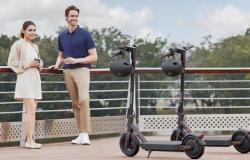One of the reasons why drones are not as widely used now as they would like to be is that most of them can only fly for about 30 minutes before the battery dies. This means they can usually only make round trips of 15 minutes, from base to destination and back.
One alternative is for them to stop at charging stations along their designated routes as needed, but these stations would still need to be built, powered and maintained. In addition, drones should only follow flight routes that include such stations.
But this is where the new solar panels come in.
The lightweight and flexible solar cells developed by researchers at Austria’s Johannes Kepler University (JKU) are made of a semiconductor material called perovskite – and are less than 2.5 micrometers thick, just 1/20 the thickness of a human hair. It is important that its 20.1 percent in terms of efficiency, they convert sunlight into electricity, and their power reaches 44 watts per gram.
In a proof-of-concept test of the technology, the researchers attached a ring-shaped array of 24 cells to a commercially available miniature quadcopter, the CX10, and dubbed it the Solar Hopper. Importantly, the array with solar panels was only 1/25 of the total weight of such a drone and its batteries, and the cells themselves were only 1/400.
In one series of tests conducted indoors, using an artificial light source that mimics sunlight, the drone hovered in the air for 10 seconds with the rotors set to half power, then landed and was left to charge for 30 minutes. The drone successfully completed six such “charge, fly, charge” cycles – and could presumably continue doing so indefinitely.
In another series of experiments, the Solar Hopper was again launched with the rotors at half power, but this time it was left running until its battery was completely discharged. These tests were performed both with and without the solar panel connected. It was found that connecting the solar battery increased the flight time by about 6 percent.
It’s not a huge amount, but on the other hand, the technology is more about allowing drones to stop and charge their batteries where the Sun’s light is available, rather than charging the batteries in flight. The researchers also point out that this number would have been higher if the drone itself had been configured to be more energy efficient.
Of course, this technology can be used for more than just charging drones.
“Ultra-thin and lightweight solar cells not only have huge potential to revolutionize the way energy is produced in the aerospace industry, but there are many other areas that could also benefit from this new technology, including wearable electronics and the Internet of Things,” says one of Christoph Putz, lead author of the study. “A lightweight, adaptable and highly efficient photovoltaic system is the key to creating a new generation of autonomous energy systems.”
The research, led by Professors Martin Kaltenbrunner and Niyazi Serdar Sariciftci, was recently published in a scientific paper in the journal Nature Energy, according to New Atlas.
Tags: Created selfcharging drone solar batteries
-





